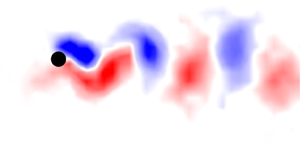Article contents
Experimental evidence of vortex-induced vibrations at subcritical Reynolds numbers
Published online by Cambridge University Press: 09 July 2021
Abstract

Shedding of vortices can be observed in the wake of a fixed cylinder at Reynolds numbers larger than  $Re=47$. This might give the impression that a vortex-induced vibration (VIV), which occurs when the frequency of vortex shedding in the wake of a flexibly mounted cylinder synchronizes with the natural frequency of the structure, could be observed only at Reynolds numbers larger than
$Re=47$. This might give the impression that a vortex-induced vibration (VIV), which occurs when the frequency of vortex shedding in the wake of a flexibly mounted cylinder synchronizes with the natural frequency of the structure, could be observed only at Reynolds numbers larger than  $Re=47$. Recent numerical simulations and theoretical work, however, have shown that it is possible to observe VIV at subcritical Reynolds numbers, i.e. Reynolds numbers smaller than
$Re=47$. Recent numerical simulations and theoretical work, however, have shown that it is possible to observe VIV at subcritical Reynolds numbers, i.e. Reynolds numbers smaller than  $Re=47$. In these studies, a VIV has been observed numerically at Reynolds numbers as low as
$Re=47$. In these studies, a VIV has been observed numerically at Reynolds numbers as low as  $Re=22$. In the present work, the first experimental evidence of VIV at subcritical Reynolds number is presented. We have designed and built an experimental set-up that makes it possible to conduct VIV experiments at subcritical Reynolds numbers, and at a constant Reynolds number over the entire lock-in range (i.e. the range for which oscillations are observed). Using this experimental set-up, we have confirmed experimentally that VIV can indeed be observed at subcritical Reynolds numbers, by observing VIV at Reynolds numbers as low as
$Re=22$. In the present work, the first experimental evidence of VIV at subcritical Reynolds number is presented. We have designed and built an experimental set-up that makes it possible to conduct VIV experiments at subcritical Reynolds numbers, and at a constant Reynolds number over the entire lock-in range (i.e. the range for which oscillations are observed). Using this experimental set-up, we have confirmed experimentally that VIV can indeed be observed at subcritical Reynolds numbers, by observing VIV at Reynolds numbers as low as  $Re=19$. We have observed subcritical VIV both when the Reynolds number stays constant over the entire lock-in range, and when the Reynolds number increases with increasing reduced velocity, while staying within the subcritical range.
$Re=19$. We have observed subcritical VIV both when the Reynolds number stays constant over the entire lock-in range, and when the Reynolds number increases with increasing reduced velocity, while staying within the subcritical range.
- Type
- JFM Rapids
- Information
- Copyright
- © The Author(s), 2021. Published by Cambridge University Press
References
REFERENCES
- 16
- Cited by





